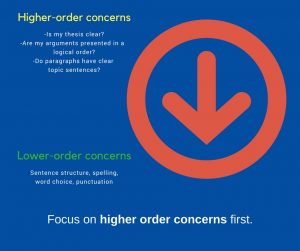Main Body
Self-Editing in Five Steps
Why Learn to Self-Edit?
While it is true that other people are valuable resources in the editing process, self-editing skills are a valuable part of your writing skill set. Why?
- Self-editing helps you develop your language skills. If you rely only on others (friends, tutors, instructors) to correct your mistakes, you are less likely to develop your writing skills to the highest possible level. By developing your self-editing skills and focusing on continually improving your writing skills, you are setting yourself up for continued growth and improvement.
- Self-editing helps you succeed in settings where you cannot rely on others for immediate help.
Self-Editing in Five Steps

Many writers are concerned about their sentence structure, grammar, and punctuation. While these concerns are important, they are usually not the best place to start the editing process. Why? The main purpose of editing is to ensure that your ideas are presented as clearly as possible. To begin the process, you will want to focus on the overall clarity and organization of the piece of writing you are creating. Can you reader logically follow the flow of your ideas? Are you presenting the ideas in the most logical way possible? It is more important to the overall success of your writing to have a strong argument, including a strong thesis statement and a well-organized presentation of your ideas. Once you have completed this “big picture” editing, which is most important to the success of your paper or report, you can then focus on the details to polish your work. Sometimes, these bigger details are referred to as “higher order concerns”, while smaller details are referred to as “lower order concerns”.
The five steps of self-editing assist you in moving from higher order concerns through to lower order concerns in a systematic way.
Step 1: Check the assignment instructions.
- Compare the instructions to your draft. Use the instructions like a checklist.
- Make a note of any elements missing from your paper, and focus your revisions on those areas.
- If you have a grading rubric, “grade” your draft according to the rubric. Note any adjustment that you want to make before submitting the paper.
Step 2: Check the thesis.
- Is it the right type of thesis for the kind of paper you are writing?
- Can it be more specific?
- Does it match the conclusions you draw in the body of the paper?
- Does it explain the significance of your argument?
Step 3: Check the body paragraphs.
- Is the topic sentence easy to identify?
- Is there evidence to support your claims?
- Is it clear how the evidence supports the claims?
- Have you explained/discussed the evidence thoroughly?
- Does the conclusion tie the paragraph’s ideas back to the topic sentence and the thesis?
- Is there a smooth transition to the next paragraph?
Step 4: Check the introduction and conclusion.
- Does the intro introduce the topic and engage the reader?
- Does the conclusion do more than repeat what you already said?
- Does the conclusion elaborate on the significance of the thesis?
Step 5: Proofread the paper.
In the next sections, you will learn key strategies to use in the proofreading process.
Remember that self-editing is a key part of the writing process. It’s also a skill that takes time to develop. The best thing about practicing self-editing is that the process of finding and revising weak areas of our writing gives us a better understanding of our strengths and weaknesses. It also reminds us what a well-developed paper looks like. All of this helps us write stronger papers in the future.

